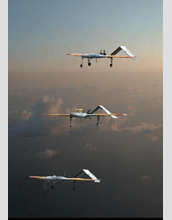Multimedia Gallery
Research Using Unmanned Aircraft
Research Using Unmanned Aircraft
A research team from the Scripps Institution of Oceanography and led by atmospheric chemist V. Ramanathan, achieved a novel way of observing the potentially damaging effects of pollution through the use of unmanned aircraft. These small and inexpensive unmanned aircraft are used to take samples of dust and pollution from within and from all sides of clouds.
After conducting a field campaign in March 2006 in the skies over the Maldives, an island nation in the Indian Ocean south of India, Ramanathan and his team concluded that the global warming trend caused by the buildup of greenhouse gases is a major contributor to the melting of Himalayan and other tropical glaciers. To learn more about this research, see National Science Foundation press release 07-087,
visit the "Brown Cloud Particulate Pollution Amplifies Global Warming." (Date of Image: 2006)
Credit: V. Ramanathan and H. Nguyen
Images and other media in the National Science Foundation Multimedia Gallery are available for use in print and electronic material by NSF employees, members of the media, university staff, teachers and the general public. All media in the gallery are intended for personal, educational and nonprofit/non-commercial use only.
Images credited to the National Science Foundation, a federal agency, are in the public domain. The images were created by employees of the United States Government as part of their official duties or prepared by contractors as "works for hire" for NSF. You may freely use NSF-credited images and, at your discretion, credit NSF with a "Courtesy: National Science Foundation" notation.
Additional information about general usage can be found in Conditions.
Also Available:
Download the high-resolution JPG version of the image. (105 KB)
Use your mouse to right-click (Mac users may need to Ctrl-click) the link above and choose the option that will save the file or target to your computer.



